The following are selected major events in the 24-day student-led protest occupying the Legislative Yuan, dubbed the Sunflower movement, that began March 18 and ended yesterday:
March 17
In a chaotic joint session of eight committees of the Legislative Yuan and a mere 30 seconds into the review of the cross-strait service trade pact, Chinese Nationalist Party (KMT) Legislator Chang Ching-chung (張慶忠), announced that the review was over and that the agreement would be submitted to the legislature. The move triggered an angry response from student activists and civic groups, as well as the opposition parties.
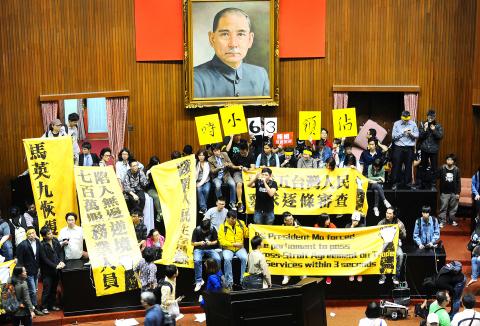
Photo: Chang Chia-ming, Taipei Times
March 18
The Democratic Front Against The Cross-Strait Trade in Services Agreement held an evening rally outside the Legislative Yuan, which turned into a storming of the legislature by hundreds of student protesters. Using swivel chairs and other furniture, they sequestered themselves in the main legislative chamber, where overnight police attempts to evict them were unsuccessful.
Hundreds of people — also mainly students — who supported the occupation gathered outside the legislative compound. The protesters’ demands included Premier Jiang Yi-huah’s (江宜樺) resignation, an apology from President Ma Ying-jeou (馬英九) and a return of the service trade pact to an item-by-item review by the legislative committees.
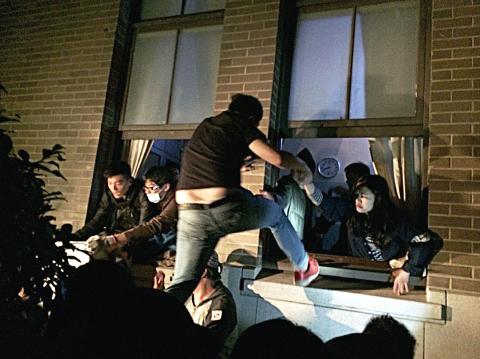
Photo: CNA
March 21
Ma called a meeting with Vice President Wu Den-yih (吳敦義), Jiang and Legislative Speaker Wang Jin-pyng (王金平) in a bid to end the confrontation, but it was canceled after Wang excused himself, saying in a letter that the nature of the dispute is different from one that would require the intervention of the head of state.
March 22
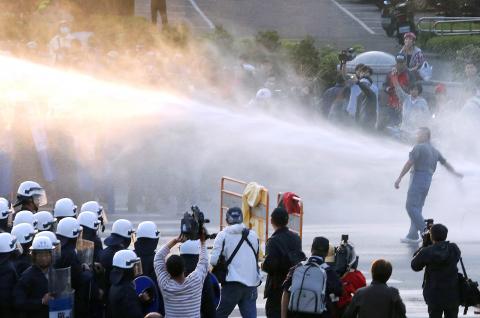
Photo: Reuters
Jiang became the first ranking administration official to see the protesters.
He was met outside the Legislative Yuan by National Taiwan University graduate student Lin Fei-fan (林飛帆) and other student leaders, who demanded that, for a dialogue to happen, the premier should promise first to withdraw the service trade pact from the legislature and to enact a new law aimed at providing close scrutiny of all agreements with China.
The brief encounter broke up after Jiang rejected the setting of preconditions for a dialogue.
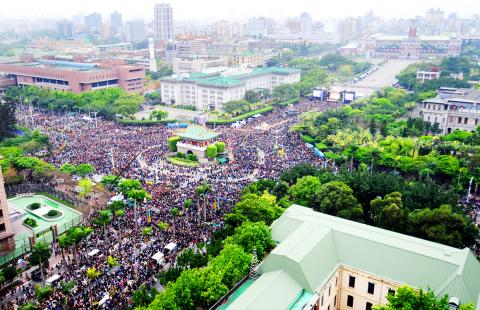
Photo: Lo Pei-der, Taipei Times
March 23
Ma called an international press conference, in which he stressed the importance of the cross-strait service trade agreement to Taiwan’s economy and its efforts to avoid marginalization. In response, the student-led movement said the president did not show any sincerity in having a dialogue with the protesters.
The students issued four demands: a civic conference on constitutional government, legalization of the mechanism for monitoring cross-strait agreements, no action on the service trade pact until the new oversight law is enacted and a pledge by all legislators to work on the new legislation first.
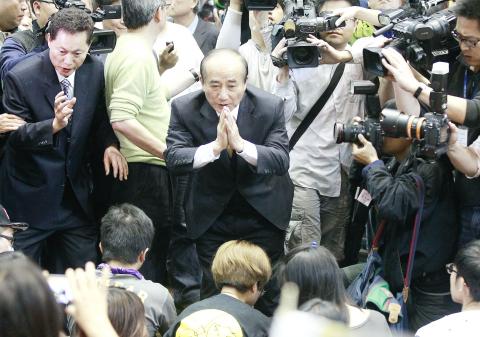
Photo: Pichi Chuang, Reuters
In the evening, hundreds of protesters broke into the Executive Yuan compound, which is about 200m from the Legislative Yuan.
As police prepared to evict the intruders, a few politicians of the Democratic Progressive Party (DPP) went to the site to support the activists. They included current and former party bosses Su Tseng-chang (蘇貞昌), Tsai Ing-wen (蔡英文) and Frank Hsieh (謝長廷).
After police reinforcements arrived, law enforcement began forcibly removing the activists after midnight, including the use of water cannons.
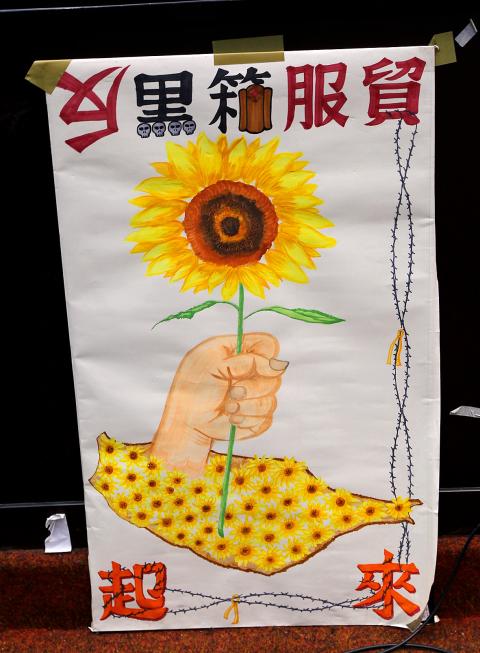
Photo: Chen Kuan-pei, Taipei Times
More than 200 people, including protesters and officers, were injured.
The compound was cleared of demonstrators by daybreak. Protesters alleged police brutality and “state violence.”
However, government officials said the police had exercised a high degree of self-restraint.
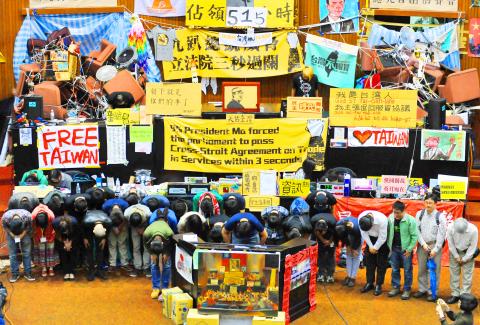
PHOTO: AFP
March 24
For the first time, Wang called on leaders of several legislative caucuses for consultations. Several more rounds of talks took place at his residence, but all broke down as senior lawmakers of the majority and opposition parties could not agree on how to handle the service trade pact.
The KMT caucus later agreed to have the pact returned to the committee stage for a detailed review, but no consensus could be reached in the consultations called by the speaker.
March 25
The president said through a spokesperson that he was willing to hold a dialogue with the students without any preconditions in order to resolve the dispute.
March 27
The student-led occupation movement called on the public to attend a rally in front of the Presidential Office Building set for March 30.
March 28
For the first time, the premier said the administration is open to the possibility of legalizing the mechanism for the oversight of all cross-strait agreements. At the same time, he rejected the students’ demand that the service trade agreement be withdrawn from the legislature.
March 29
The president held a second press conference to explain the administration’s position on the dispute.
March 30
A peaceful rally of demonstrators dressed in black took place on Ketagalan Boulevard in front of the Presidential Office Building. Organizers said as many as 500,000 took part in the event.
Police said the number was 116,000 at its peak.
March 31
KMT legislator Chang and Lin Hung-chih (林鴻池), chief whip of the KMT legislative caucus, apologized for the social turmoil following their action on March 17.
April 1
The China Unification Promotion Party, founded by former leader of the Bamboo Union gang “White Wolf” Chang An-le (張安樂), and some labor groups supportive of the service trade pact marched on the Legislative Yuan and demanded that the authorities take action against the student-led occupation of the legislative chamber. Once there, they confronted the protesters and some DPP politicians. Police struggled to separate the two opposing camps.
April 3
In a weekly meeting, the Executive Yuan approved a draft bill aimed at increasing the oversight of cross-strait agreements.
Protest leader Chen Wei-ting (陳為廷), a graduate student at National Tsing Hua University, rejected the text of the bill as “mere form.”
As many as 10 alternate versions of the proposed legislation were being discussed by the students.
April 6
Wang returned to the Legislative Yuan for the first time since March 18 after declaring that he would not call any cross-party caucus meetings on the service trade pact until the new oversight law has been enacted.
Once in the main chamber, he shook hands with Lin and urged all students to go home.
April 7
The student leaders said they would evacuate the legislative chamber at 6pm yesterday.
Source: CNA

US climber Alex Honnold is to attempt to scale Taipei 101 without a rope and harness in a live Netflix special on Jan. 24, the streaming platform announced on Wednesday. Accounting for the time difference, the two-hour broadcast of Honnold’s climb, called Skyscraper Live, is to air on Jan. 23 in the US, Netflix said in a statement. Honnold, 40, was the first person ever to free solo climb the 900m El Capitan rock formation in Yosemite National Park — a feat that was recorded and later made into the 2018 documentary film Free Solo. Netflix previewed Skyscraper Live in October, after videos

Starting on Jan. 1, YouBike riders must have insurance to use the service, and a six-month trial of NT$5 coupons under certain conditions would be implemented to balance bike shortages, a joint statement from transportation departments across Taipei, New Taipei City and Taoyuan announced yesterday. The rental bike system operator said that coupons would be offered to riders to rent bikes from full stations, for riders who take out an electric-assisted bike from a full station, and for riders who return a bike to an empty station. All riders with YouBike accounts are automatically eligible for the program, and each membership account

NUMBERS IMBALANCE: More than 4 million Taiwanese have visited China this year, while only about half a million Chinese have visited here Beijing has yet to respond to Taiwan’s requests for negotiation over matters related to the recovery of cross-strait tourism, the Tourism Administration said yesterday. Taiwan’s tourism authority issued the statement after Chinese-language daily the China Times reported yesterday that the government’s policy of banning group tours to China does not stop Taiwanese from visiting the country. As of October, more than 4.2 million had traveled to China this year, exceeding last year. Beijing estimated the number of Taiwanese tourists in China could reach 4.5 million this year. By contrast, only 500,000 Chinese tourists are expected in Taiwan, the report said. The report

Temperatures are forecast to drop steadily as a continental cold air mass moves across Taiwan, with some areas also likely to see heavy rainfall, the Central Weather Administration (CWA) said. From today through early tomorrow, a cold air mass would keep temperatures low across central and northern Taiwan, and the eastern half of Taiwan proper, with isolated brief showers forecast along Keelung’s north coast, Taipei and New Taipei City’s mountainous areas and eastern Taiwan, it said. Lows of 11°C to 15°C are forecast in central and northern Taiwan, Yilan County, and the outlying Kinmen and Lienchiang (Matsu) counties, and 14°C to 17°C